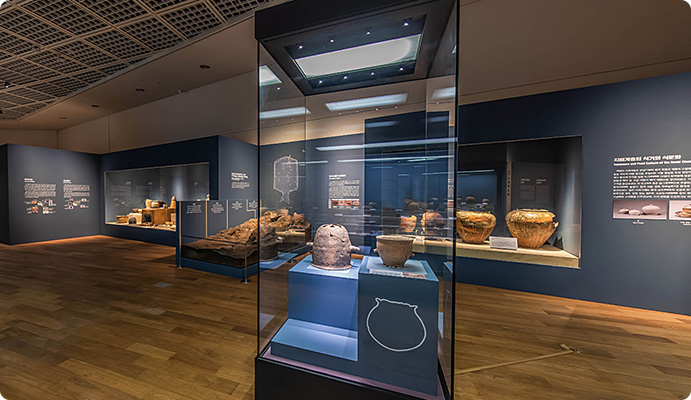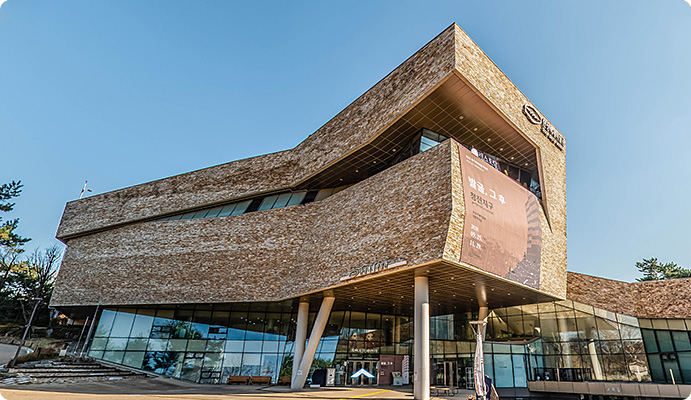Seoul Baekje Museum


Of a total of 678 years of Baekje History, Seoul was the capital city for 493 years. Therefore, there are prominent Hanseong Baekje era ruins here such as the Pungnap Fortress, Mongchon Fortress and Seokchon-dong Tomb Complex, where tens of thousands of relics were excavated. Now, Seoul Metropolitan City is carrying forward the plan for construction of Seoul Baekje Museum to preserve those relics systemically and review the 2000-year history of Seoul while establishing its cultural identity. The Seoul Baekje Museum, established on a site overlooking the Mongchon Fortress in the Olympic Park, opened its door to the public in April, 2012.
The Seoul Baekje Museum will take an essential role in the historical research into the Hanseong Baekje era and act as a bridge over the 2000-year-long history of Seoul. It will allow visitors to enjoy the rich culture and give Seoulites a sense of pride about their history. Furthermore it is expected to attract up to 12 million foreign tourists. The Seoul Baekje Museum will enrich Seoul Metropolitan City, where traditions and the present co-exist harmoniously.
Purpose of Establishment
Seoul has a long and rich history and was the capital of the Baekje Dynasty for about 500 years (B.C 18~ A.D. 475). Many large settlements were already established in the Neolithic Age and their traces can be still found in numerous areas including the Amsa-dong Prehistoric Settlement, Poongnap Fortress, Mongchon Fortress and Seokchon Tomb Complex. Since ancient times, the Han River, traversing Seoul City, has been an essential transport route and helped to create fertile farmlands along its course. With those merits, Seoul was a flourishing industrial hub that had been the stage for several wars during the Three Kingdom period (Baekje, Shilla and Goguryeo). This has been proved by various excavated relics scattered around Seoul area.
In recent years, tens of thousands of Baekje-era relics were excavated from the Poongnap Fortress, unearthing hidden historic stories with their emergence. However, they were still in a poor condition, making it difficult to manage and utilize these relics as educational materials. Besides, we were advised to strive harder to cherish the prehistoric remains and make the best use of them. Now, Seoul Metropolitan City is establishing the Seoul Baekje Museum, which will efficiently manage the valuable relics and attract many visitors as well. Following this agenda, the Seoul Baekje Museum will lead the diverse researches on the buried relics around Seoul area and manage the existing excavated relics in a systematic way.
Furthermore, by developing the prehistoric relic trails in connection with the other tourist spots, the Seoul Baekje Museum will invigorate its functional purpose and quench citizens’ thirst for the historic culture.
Museum Outline
- Address : 71, Wiryeseong-daero, Songpa-gu, Seoul, Republic of Korea (Inside the Olympic Park)
- Construction Period : July 2007 ~ December 2011
- Site Area : 14,894㎡
- Museum Size : 18,953㎡ (2 floors above ground, 3 underground)
- Collections : Prehistoric / Ancient relics around Seoul and Gyeonggi
| Area | Details | Size |
|---|---|---|
| Exhibition Area | 3 Permanent Halls, Special Exhibition, Lobby Exhibition | 2,972㎡ |
| Storage Area | 4 Storage Rooms, Management Room | 2,706㎡ |
| Educational Area | Auditorium, Class Room, Library | 1,182㎡ |
| Office Area | Director’s Room, Offices | 643㎡ |
| Amenities | Cafeteria, Museum Shops | 801㎡ |
| Public Area | Main Hall, Hallways, Etc. | 4,191㎡ |
| Maintenance Area | Electric Room, Machinery Room | 1,682㎡ |
| Basement Parking Area | Underground level 2, 3 | 4,776㎡ |